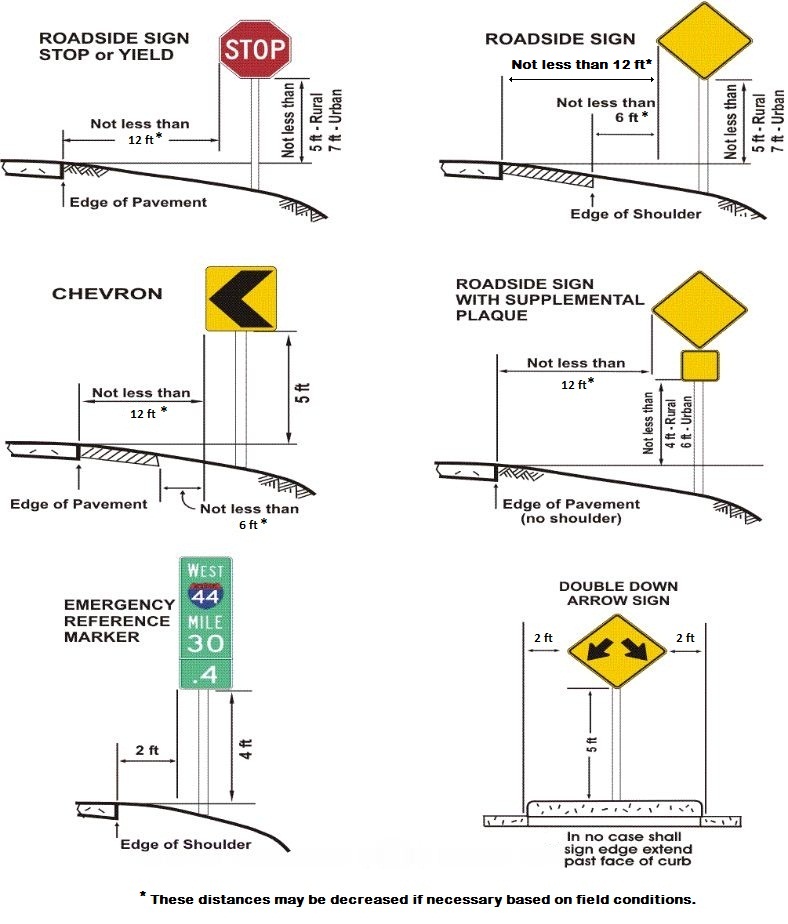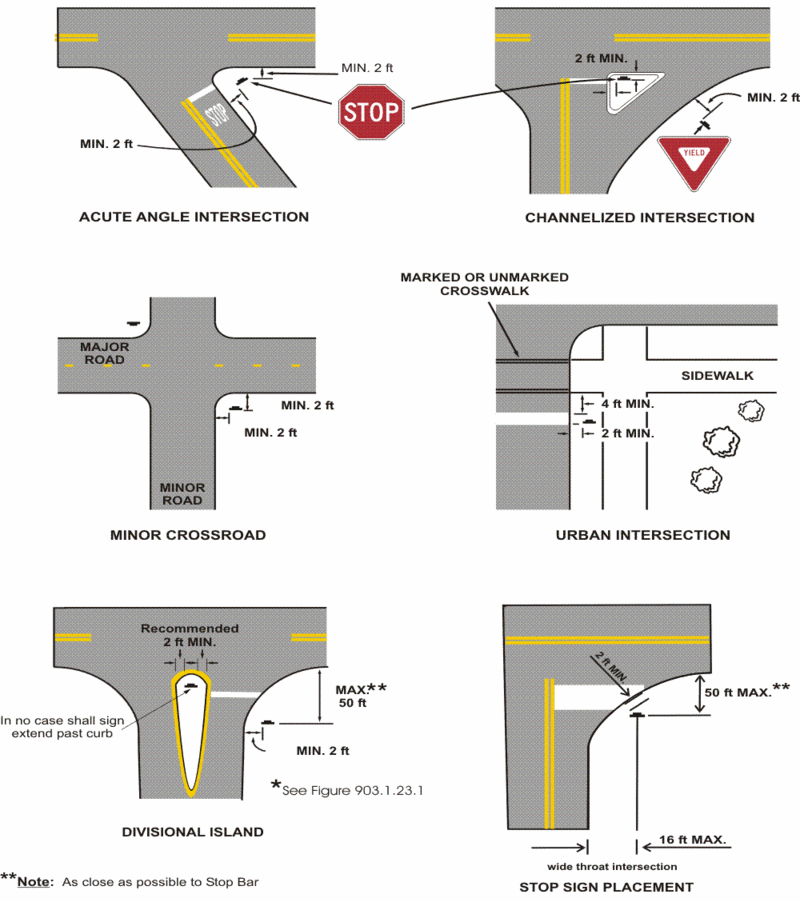903.2 Extent of Signing
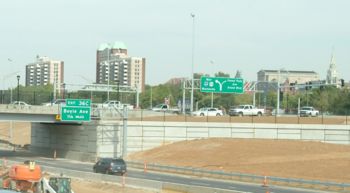
903.2.1 Scope of Signs and Signing
Standard. The extent of signing by contract on any project is determined early in the project scope. Structural guide signs and supports (overhead or post-mounted) are paid for by contract, regardless of the type of facility. Sheet signs and supports are supplied by contract for all route classifications and project conditions. Unless otherwise agreed to among departments or divisions, the following are general guidelines for the extent of contract signing.
Guidance. Regulatory and warning signs should be used conservatively because these signs tend to lose effectiveness if they are used to excess. If used, route signs and directional signs should be used frequently because they promote reasonably safe and efficient operations by keeping road users informed of their location.
903.2.2 Signing on Interstates, Freeways and Expressways with Full Access Control
Support. Complete signing (structural and sheet signs, supports, delineators, etc.) is provided by contract for these roadways and all directly affected side roads, interchanges or intersections.
903.2.3 Signing on Urban Projects
Support. Structural ground-mounted or overhead guide signs and supports are supplied by contract. Delineators, when specified, are furnished and installed by contract.
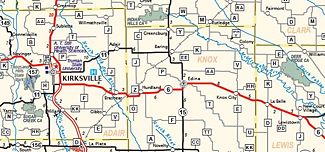
903.2.4 Signing on Rural Projects
Support. Structural overhead and ground-mounted guide signs and sign supports are supplied by contract. When an interchange is within the limits of a rural project, route markers, guide, regulatory and warning signs within the interchange limits are supplied by contract. Delineators, when specified, are furnished and installed by contract.
903.2.5 Sign Function and Purpose (MUTCD Section 2A.01)
Support. The functions of signs are to regulate, warn and guide road users. Words, symbols and arrows are used to convey the messages. Signs are not typically used to confirm rules of the road. Detailed sign requirements are available for:
- 1. Regulatory signs
- 2. Warning signs
- 3. Guide signs for conventional roads
- 4. Guide signs for freeways and expressways
- 5. General information signs
- 6. General service signs
- 7. Specific service (LOGO) signs
- 8. Tourist-oriented direction signs
- 9. Changeable message signs
- 10. Recreational and cultural interest area signs
- 11. Emergency management signs
- 12. Typical applications
- 13. Sign supports.
Signing of all interstate highways is coordinated on a national basis and signing of highways other than the interstate system is coordinated on a statewide bases by MoDOT.
Standard. Because the requirements and standards for signs depend on the particular type of highway upon which they should be used, the definitions for freeway, expressway and conventional roads given in EPG 900.1.13 Definitions of Headings, Words and Phrases shall apply to all signing.
Any exceptions or requests for a regulatory or warning sign, or any sign for use on the Interstate system not described in this article shall be submitted to the State Traffic Engineer for consideration.
Special signs or special use of a sign that is not regulatory or warning, or any sign intended for use on the Interstate system shall be used at the district engineer’s discretion. If the special sign is not compliant with the MoDOT sign policy the sign shall not be funded from Central Office budget.
The provisions of the EPG shall be followed for all special signs.
Guidance. When a special sign is approved by district discretion, consideration should be given to any statewide implication from the sign, cost to the state and the precedence the sign may set. Advise Central Office Traffic of any special signing approved by the districts so that this information can be shared with other districts. This will provide a basis for other districts when considering similar requests.
903.2.6 Definitions (MUTCD Section 2A.02)
Support. Definitions and acronyms that are applicable to signs are in EPG 900.1.13 Definitions of Headings, Words and Phrases.
903.2.7 Standardization of Application (MUTCD Section 2A.03)
Support. Urban traffic conditions differ from rural conditions and in many instances signs are applied and located differently. Where pertinent and practical, this article sets forth separate recommendations for urban and rural conditions.
Guidance. Signs should be used only where justified by engineering judgment or studies. Results from traffic engineering studies of physical and traffic factors should indicate the locations where signs are deemed necessary or desirable.
Roadway geometric design and sign application should be coordinated so that signing can be effectively placed to give the road user any necessary regulatory, warning, guidance, and other information.
Standard. Each standard sign shall be displayed only for the specific purpose as prescribed in this article. Determination of the particular signs to be applied to a specific condition shall be made according to the provisions set forth in this article. Before any new highway, detour or temporary route is opened to public travel, all necessary signs shall be in place. Signs required by road conditions or restrictions shall be removed when those conditions cease to exist or the restrictions are withdrawn.
903.2.8 Excessive Use of Signs (MUTCD Section 2A.04)
Guidance. Regulatory and warning signs should be used conservatively because these signs, if used to excess, tend to lose their effectiveness. If used, route signs and directional guide signs should be used frequently because their use promotes efficient operations by informing travelers of their location.
903.2.9 Extent of Contract Payments
Standard. All structural guide signs and supports (overhead or ground mounted) are paid by contract, regardless of the type of facility. All sheet signs and supports are supplied by contract for all route classifications and project conditions. Exceptions shall be made only by Central Office Traffic.
903.2.10 Plan Development Procedure
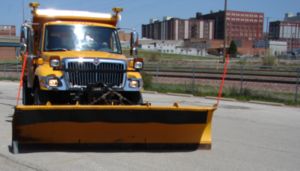
Standard. The preparation of signing plans requires the cooperation and coordination between the district and Central Office.
When using preexisting structures to accommodate larger new signs, consideration shall be given to the dimensions and load capacity of the existing structure. The larger signs shall properly fit on the existing structure and not exceed the structure’s design capacity.
When the need arises to modify the legend of a sign not built to current standards, the entire sign shall be replaced.
Guidance. Bridge Division should be consulted for mounting signs directly on bridges and other structures.
Sign visibility from a distance is critical. Sign locations should be coordinated with other design features that include, but are not limited to bridges, highway lighting, traffic signals, drainage structures, overhead utilities, underground utilities and horizontal and vertical alignments that decrease sign visibility.
The district should prepare proposed sign locations and review the plans for standards and quality control.
When the sign is mounted on a truss, all signs on the truss not built to current standards should be replaced after considering the age, future conditions and detail of the sign.
It is recommended that all non-standard signs be identified, with justification for the non-standard designs.
For preliminary discussions, only the sign location plan showing existing and proposed signing is recommended. Sign details, cross-sections, tabulation sheets, computer generated sign designs or other detailed information should not be completed at this time. Once the preliminary location plan is agreed on, the district is to prepare forms D-29 and D-30, truss data sheets and template cross-sections for trusses and post-mounted signs. Truss cross-sections should not be drawn on the same sheets as ground mounted sign cross-sections. The districts are responsible for accuracy of the preliminary and final detail design.
The district finalizes the plans and is to submit them to Design with the roadway plans, or as a separate project if so programmed. Typical signing location plans for interchanges are shown in EPG 903.17 Typical Signing Applications. Design Division is available for consultation during any part of the plan preparation process.
All non-standard and special signs are detailed by Central Office Traffic and the district is responsible for incorporating the signs in Form D-31. A Sign Design Order Form (Design Form D-28) should be completed for allnon-standarad and special signs and sent to Central Office Traffic as soon as the signs are identified.
Preliminary layouts of special signs should be submitted along with the completed D-28 form to Central Office Traffic so the final design can be produced. The sign designs can be inserted into the special sign detail sheets (D-32). All special signs should be designed by Central Office Traffic. District Traffic should review all signs.
Luminaires should not be used for overhead signs.
Option. Design or Traffic may provide comments on the preliminary layout at the district's request. It is suggested that districts form review teams from various departments to review plans at the preliminary layout stage, and at final design. After the district reviews plans, Design Division may be consulted for review at the district's discretion.
Two or more segments of alignment may be shown on one sheet. For ease of design, review and construction, sign locations for interchanges are completely shown on one sheet.
In complex areas where many signs exist and will be replaced, proposed signing and existing signing may be shown separately on different plan sheets to avoid clutter and plan confusion; however, combined is preferred, if possible.
Support. Fig. 903.2.10.1 and Fig. 903.2.10.2 show the steps taken from early plan development to final design
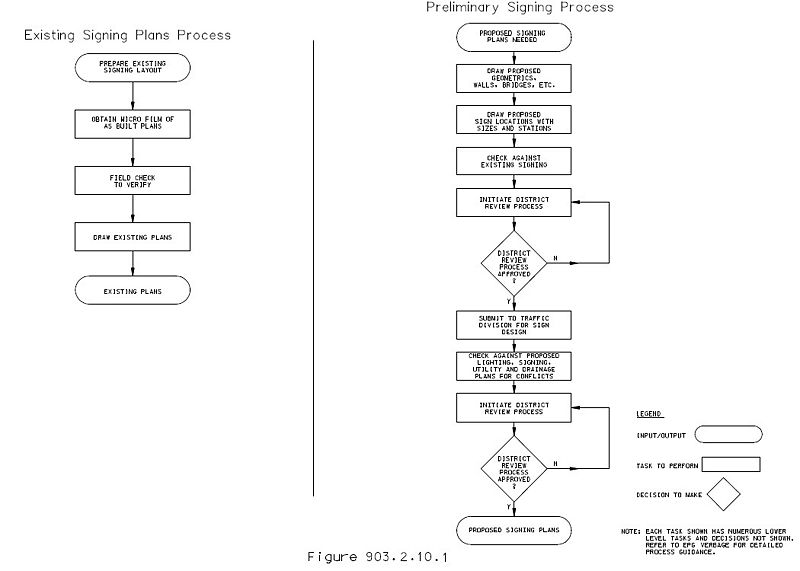 |
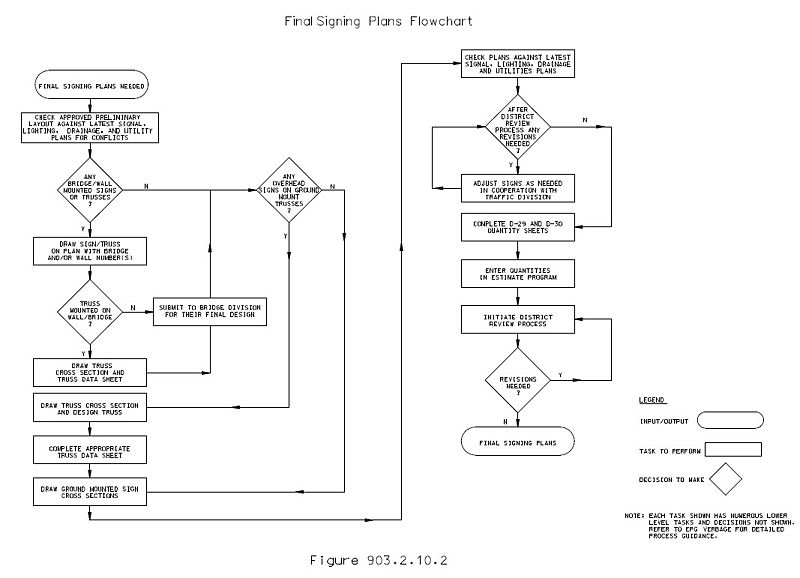 |
Support. Figure 903.2.10.1 and Figure 903.2.10.2 provide steps taken from early plan development to final design.
Location plans show the proposed pavement geometrics, the sign location, sign number, station, width and height, sign code (if applicable) and special or standard legend. Sign sizes are shown as width x height, in feet and/or inches for sheet signs, and in feet only for structural signs. Tabulated removals and general information is show for existing signs. The standard sign code (i.e. R5-1a, W10-1, etc.) is shown for signs found in the standard plans.
Signs are numbered in a logical order. Existing signs that are removed or remain in place are not numbered. Multiple signs on a single mount are further indicated with lower-case letters (i.e. 45(a), 45(b), 45(c)). If signs are added or deleted at a later date, renumbering all signs is not required. If signs are added, signs may be numbered 43, 43A, 43B, etc., or the next highest sign number may be used. If signs are deleted, a general note listing voided signs is provided.
Existing signs are shown with dashed lines and are listed as a removal item where appropriate. Existing signs to be relocated to new posts and new signs on existing posts are numbered and noted as such. Existing signs in poor condition should be replaced.
When replacing signs for many miles of roadway to be let in sections, it is desirable to generate an overall sign location plan to coordinate guide sign placement through numerous projects. For this situation it is not necessary to show signs other than guide signs. It is recommended to show the limits of each project on this location plan. Signs are identified as truss, bridge- or post-mounted or as strapped to a signal post or column. If applicable, truss type (cantilever, span and butterfly) and location are shown. Whether the truss is box or tubular does not need to be noted on preliminary location plan, but is shown on the final plan. A standard legend identifying symbols is used to alleviate crowding on plans. Typical location plans at interchanges are shown in EPG 903.17 Typical Signing Applications.
Truss pedestals are not placed in gore areas or other areas that have high exposure to traffic.
A number of standard signs are detailed in SMS Sign Catalog and in the standard plans. Special sign detail sheets are not required for signs detailed in these references.
When staged projects are scheduled in unison or closely together, complete signs are provided with the inappropriate legend covered until needed. Legends to be covered are noted on the plans, and the engineer is to approve the covering method. No direct pay is made for covering legends. When structural signs should be erected with only part of the legend in place at the initial time of construction, the sign and legend are shown on the plans with solid lines, and the legend to be placed at a later date is shown with dashed lines. A note is included indicating the dashed legend will be provided by future construction. The omitted legend is included in the roadway contract, which completes the sign.
When the legend of an existing sign built to current standards is modified, the existing sign and legend are shown with dashed lines and the legend to be added is shown with solid lines. Sufficient information is provided to show series, type, size and spacing of new legend on the sign detail sheet.
The district prepares tabulation sheets on Forms D-29 (Sign Posts, Footings, Delineators and Mileposts), D-30 (Signs) and Data Sheets D-32, D-33 and D-34. These forms are available as MicroStation seed files.
On Form D-29, all signs are listed in order according to sign number. This form includes truss footing and pedestal concrete quantities.
On Form D-30, all standard signs are totaled on the left-hand side of the sheet. The right-hand side is used to list special signs and provides an overall summary of all sign types.
Truss data sheet forms are completed for all trusses. Form D-32 is used for cantilever and butterfly box trusses. Form D-33 is used for span and span-cantilever box trusses. Form D-34 is the truss data sheet used for all tubular sign supports.
Design variances require district justification at the preliminary sign location stage. Signing variances are also noted in the plans. Some deviations from design standards require approval.
Overhead sign support structure foundations are not placed in gore areas or other areas with high exposure to traffic. See EPG 903.4 for additional overhead sign support structure information.
903.2.11 Signing Plans
Standard. When signing is a separate project, the plans are assembled in the following order:
- 1. title sheet
- 2. quantity sheets for roadway items
- 3. sign location plan sheets
- 4. special sheets
- 5. traffic control plans
- 6. erosion control plan
- 7. tabulation sheet (D-29)
- 8. tabulation sheet (D-30)
- 9. special sign detail sheets (D-31)
- 10. design data sheets for cantilever and butterfly box trusses (D-32)
- 11. design data sheets for overhead span box trusses (D-33)
- 12. design data sheet for tubular trusses (D-34)
- 13. truss cross-section sheets
- 14. cross-sections for post-mounted signs
- 15. special sheets for bridge-mounted signing
Typically, signing is included with the roadway plans. When this is the case, the plans are assembled together, including the quantity sheets. Separate quantity sheets shall not be generated for signing quantities. The signing plans shall be arranged in the following order:
- 1. sign location plan sheet
- 2. tabulation sheet (D-29)
- 3. tabulation sheet (D-30)
- 4. special sign detail sheets (D-31)
- 5. design data sheets for cantilever and butterfly box trusses (D-32)
- 6. design data sheets for overhead span box trusses (D-33)
- 7. design data sheet for tubular trusses (D-34)
- 8. truss cross-section sheets
- 9. cross-sections for post-mounted signs
- 10. special sheets for bridge-mounted signs
- 11. any miscellaneous special signing detail sheets.
903.2.12 Quantity Computations
Standard. Signs and posts will each be paid for individually. This includes emergency reference markers and object markers. Combined unit prices for sign and support combinations have been discontinued. All signs including stop signs, object markers, emergency reference markers and signal signs shall be totaled on Form D-30 in four categories: Flat Sheet (FS), Flat Sheet Fluorescent (FSF), Structural (ST) and Structural Fluorescent. Structural signs’ width and height are designed to the nearest foot. Each standard, non-standard or special sign shall be calculated to the nearest 0.1 sq. ft., subtotaled to the nearest 0.1 sq. ft., and final pay total should the nearest 1.0 sq. ft.
All post quantities shall be calculated and totaled on Form D-29. All post lengths shall be calculated in increments of 0.25 ft. including the length that extends into the concrete footing or ground as shown on the standard plans. All U-channel post lengths shall include the full length of both pieces when overlaps are required. The post length for wide flange and pipe posts shall be multiplied by the pounds per foot (lb/ft) factor, as shown in the standard plans; each sign's posts are subtotaled to the nearest pound; all sign posts are subtotaled; and the final pay totals are shown to the nearest 10 pounds. All U-channel, wood and perforated square steel tube post length quantities shall be totaled and rounded to the nearest foot. For perforated square steel tube posts, an additional pay item shall be included for the anchor sleeve which is paid for by the linear foot for each post used (and may also include a soil plate). See the Post and Anchor Data Table in Standard Plan 903.03 to select the necessary anchor size. Omni-Directional anchors may be used for installation in weak or loose soil conditions.
Concrete for sign support structures shall be totaled on Form D-29. Concrete for overhead structure foundations shall be bolted down. Concrete for all post-mounted sign foundations shall be embedded. Bolted down and embedded quantities shall be calculated for each sign to the nearest 0.01 cubic yard, subtotaled to the nearest 0.01 cubic yard and a final pay total is shown to the nearest 0.1 cubic yard.
Cantilever and butterfly tubular support trusses shall have standard pay items. Span tubular trusses shall require special pay items. Information in the description shall include span length, truss number and span design type. Structure pay items shall include costs for all labor and materials associated with the structure, from the bottom of the base plate up, on up, as a lump sum item. Each span structure shall have a separate pay item. Structure data shall be provided on Form D-34.
All box trusses shall require a special pay item for each truss. All pay item descriptions shall include span length and truss number. Truss pay items shall include costs for all labor and materials associated with the truss, from the bottom of the base plate up, as a lump sum item. Each box truss, regardless of type, shall have a separate pay item.
See Standard Plan 903.03 for payment of delineators. Delineators shall be paid for per each on Form D-29, and include installation, bolts, post and sign.
Perforated Square Steel Tube Post Breakaway assemblies shall be totaled on Form D-29. Breakaway assemblies are incidental for pipe and structural steel posts.
Backing bar lengths and weights shall be shown on Form D-29, and are totaled with the pay item for structural steel posts. No weight deductions shall be made for punched or drilled holes. If no structural steel posts are used on a project, backing bar weights shall be added to pipe post weights.
Signal Sign Mounting Hardware shall be paid for per each on Form D-37A separate from signal signs, which will be paid for by square feet. Signal Sign Hardware will include all mounting hardware necessary to install one sign on the mast arm.
Special pay items shall not be included for items considered to be small amounts of work such as: strapping signs to lighting or signal posts or truss columns; covering inappropriate legends; "EXIT ONLY" panels on new signs; any symbol, arrow, shield or legend on new guide signs; hinge plates; aluminum wide flange posts for connecting service signs and exit number panels to structural guide signs; etc. No additional payment shall be made for hardware. Other than the above, it shall be left to the designer to decide which items require direct pay.
Option. Special pay items for signing may be required. Some examples of special work include: modifying legends, relocating existing signs to new posts, temporary ground mounting guide signs, bridge mounted support brackets, truss painting, pedestal repair, etc. It is left to the designer to decide which items require special pay items.
Support. Most jobs include the removal of existing signs and/or trusses. All removals are listed with other roadway Removal of Improvements. It is preferred to list the type of truss to be removed, number of pedestals, posts, footings and a rough estimate of sign area. Consult the District Traffic Engineer or District Constructions and Materials Engineer about which removals to salvage and where the contractor should deliver the salvaged materials. Items to be salvaged and delivery of these items are mentioned in the job special provisions and this work is paid for under Removal of Improvements.
903.2.13 Classification of Signs (MUTCD Section 2A.05)
| Major sporting events are traffic generators | |
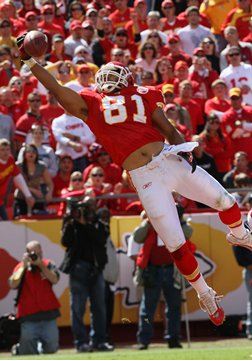 |
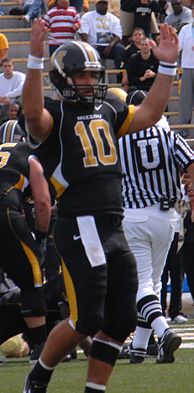
|
Standard. Signs shall be defined by their function as follows:
A. Regulatory signs give notice of traffic laws or regulations.
B. Warning signs give notice of a situation that might not be readily apparent.
C. Guide signs show route designations, destinations, directions, distances, services, points of interest and other geographical, recreational, or cultural information.
The order classification of signs shall be defined as follows (refer to Fig 903.2.13):
1. First Order Signing. Signs that are installed in advance of the closest intersection or interchange where motorists turn off of the state highway system to arrive at the desired traffic generator or site. First order signing will always be on state right of way.
2. Second Order Signing. Signs that are installed in advance of the intersection or interchange where motorists turn to access the highway where the first order signing is provided. Second order signing will always be on state right of way and shall require the use of first order signing on state right of way.
3. Third Order Signing. Signs that are installed in advance of the intersection or interchange where motorists turn to access the highway where the second order signing is provided. Third order signing will always be on state right of way and shall require the use of first order and second order signing on state right of way.
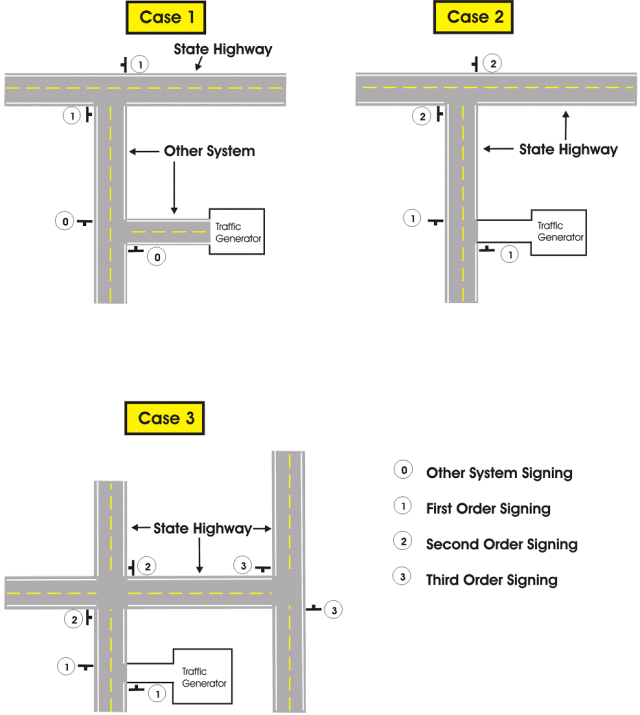
Support. In general, as the “order” of signing increases, the functional classification of road stays the same or increases. For example, if first order signing is on a four-lane U.S. route, second order signing should be on another U.S. route, expressway or a freeway. In this example case, second order signing should not be placed on a two-lane lettered route.
903.2.14 Sign Design (MUTCD Section 2A.06)
Support. EPG 903 shows many typical standard signs approved for use on streets, highways, bikeways and pedestrian crossings.
In the specifications for individual signs, the general appearance of the legend, color and size are shown in the accompanying tables and illustrations, and are not always detailed in the text.
Detailed drawings of all highway signs and alphabets are provided by Central Office Traffic Division.
A highway sign must be legible to those for whom it is intended and be understandable from a distance to permit a proper response. It is desirable for it to be highly visible by day and night and highly legible (i.e., adequately sized letters, symbols or arrows and a short legend for quick comprehension by a road user approaching a sign). Standardized colors and shapes are specified so that the several classes of traffic signs can be promptly recognized. Simplicity and uniformity in design, position, and application are important.
Standard. The term legend shall include all word messages and symbol and arrow designs that are intended to convey specific meanings.
Uniformity in design includes shape, color, dimensions, legends, borders and illumination or retroreflectivity.
Standardization of these designs does not preclude further improvement by minor changes in the proportion or orientation of symbols, width of borders, or layout of word messages, but all shapes and colors shall be as indicated.
All symbols shall be unmistakably similar to, or mirror images of, the adopted symbol signs, all of which are shown in EPG 903. Symbols and colors shall not be modified unless otherwise provided in the EPG. All symbols and colors for signs not shown in the EPG and SMS Sign Catalog shall follow the procedures for experimentation and change described in EPG 903.
Option. Although the standard design of symbol signs cannot be modified, the orientation of the symbol may be changed to better reflect the direction of travel, if appropriate.
Standard. Where a standard word message is applicable, the wording shall be as provided in this article.
In situations where word messages are required other than those provided in this article, the signs shall be of the same shape and color as standard signs of the same functional type.
Option. MoDOT, with the approval of Central Office Traffic Division, may develop special word message signs in situations where roadway conditions make it necessary to provide road users with additional regulatory, warning or guidance information, such as when road users need to be notified of special regulations or warned about a situation that might not be readily apparent. Unlike colors that have not been assigned or symbols that have not been approved for signs, new word message signs may be used without the need for experimentation.
Standard. Expect as provided in this article and except for the Carpool Information sign, internet addresses and e-mail addresses, including domain names and uniform resource locators (URL), shall not be displayed on any sign, supplemental plaque, sign panel (including logo sign panels on Specific Service signs) or changeable message sign.
Guidance. Unless otherwise provided in this article for a specific sign or as provided in the Option below, telephone numbers with more than four characters should not be displayed on any sign, supplemental plaque, sign panel (including logo sign panels on Specific Service signs) or changeable message sign.
Option. Internet addresses, email addresses or telephone numbers with more than four characters may be displayed on signs, supplemental plaques, sign panels, and changeable message signs that are intended for viewing only by pedestrians, bicyclists, occupants of parked vehicles, or drivers of vehicles on low-speed roadways where engineering judgment indicates that an area is available for drivers to stop out of the traffic flow to read the message.
Standard. Pictographs shall not be displayed on signs except as specifically provided in this article. Pictographs shall be simple, dignified and devoid of any advertising. When used to represent a political jurisdiction (such as a county or municipal corporation) the pictograph shall be the official designation adopted by the jurisdiction. When used to represent a college or university, the pictograph shall be the official seal adopted by the institution. Pictorial representations of university or college programs shall not be permitted to be displayed on a sign
903.2.15 Types of Fabricated Signs
Support. There are two types of sign material available, structural (ST) and sheet (SH).
Sheet signs are sheet aluminum, usually one-piece units, and have several available thicknesses as indicated in the standard plans.
Structural signs are usually made of multiple extruded panels. These signs are used primarily for guide signs on expressways and freeways, but may be found on other routes on a limited basis, and are used on all overhead-mounted signs, including “LOW CLEARANCE” and exit number panels, signs greater than 6 ft. wide, and signs greater than 30 sq. ft. in area.
Extruded panels are composed of a 1 ft. tall "E" shaped aluminum substrate, assembled to a desired height and cut to a uniform width for each sign. These panels are bolted together to form the larger “blank” substrate needed for structural signs.
903.2.16 Types of Legend
Support. Two different legend types are available, L-1 and L-3. Each has a particular use in signing.
L-1 is a screen process applied character, or "painted" character. L-1 is used for many smaller sheet signs such as speed limits, yields, one way, etc. L-1 is also specified for the reverse silk-screen process that is used for red series signs.
L-3 is a direct applied character, which means the entire character surface adheres to the sign panel. L-3 is required for all overhead and ground mounted guide signs with a white legend on green, blue or brown background. L-3 may also be used on signs that are too large to screen process, such as "EXIT ONLY" panels.
903.2.17 Retroreflectivity and Illumination (MUTCD Section 2A.07)
Support. There are many materials currently available for retroreflection (see Fig. 903.2.17.1 and Fig. 903.2.17.2) and various methods currently available for the illumination of signs. New materials and methods continue to emerge. New materials and methods can be evaluated as long as the signs meet the standard requirements for color, both by day and by night.
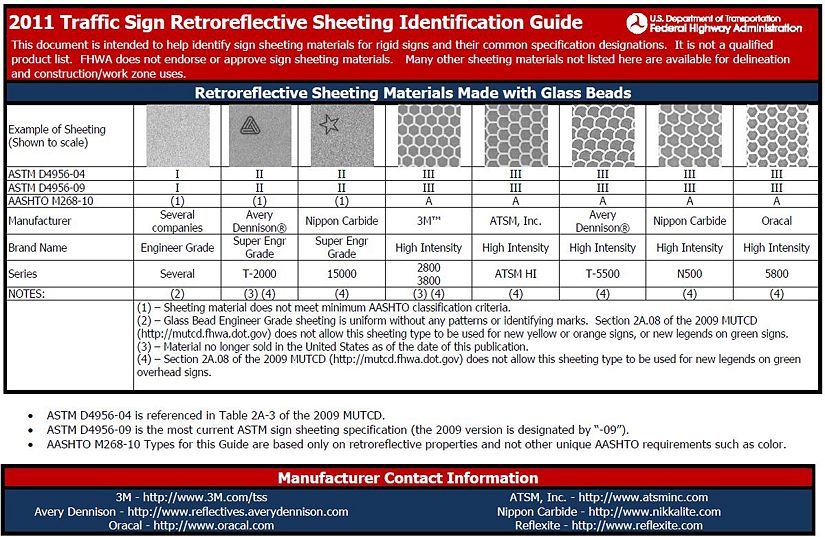
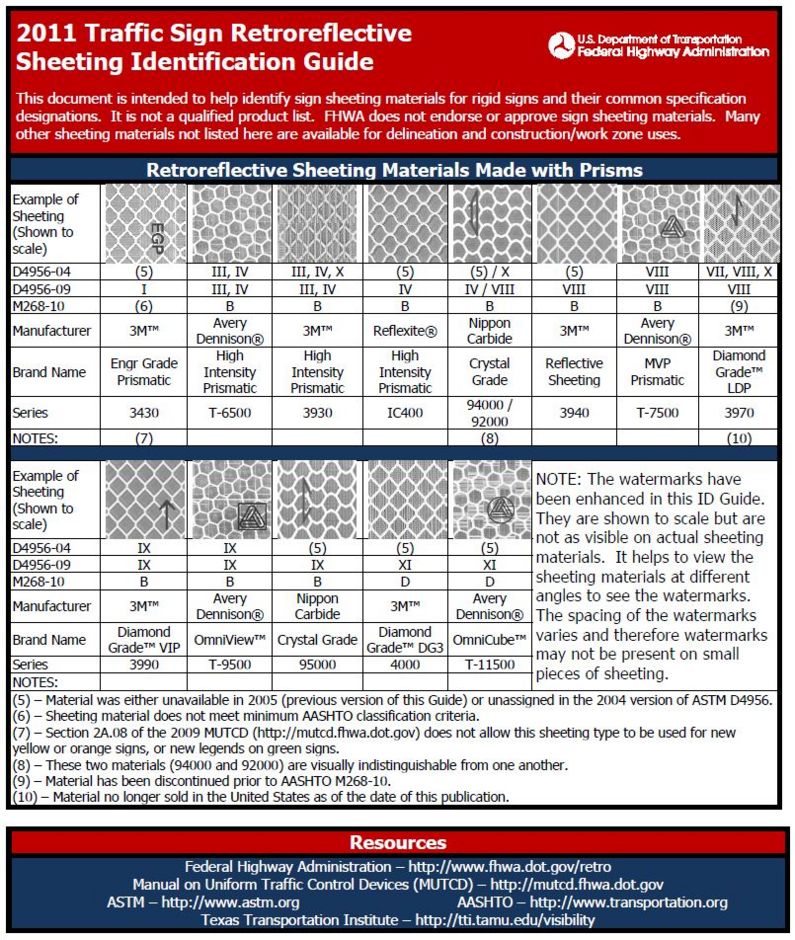
There are two types of reflective sheeting available to MoDOT:
- 1) MoDOT Type III High Intensity Prismatic (R2)
- 2) MoDOT Type VII Prismatic (R4).
For special sign designs, the type of reflective sheeting is noted on the special sign detail sheet (indicated as “BACKGROUND”).
Standard. Regulatory, warning, guide signs and object markers shall be retroreflective or illuminated to show the same shape and similar color by both day and night, unless otherwise provided in this article for a particular sign or group of signs.
The requirements for sign illumination shall not be considered to be satisfied by street or highway lighting.
Guidance. Generally, R2 sheeting should be used on all sign backgrounds. R3 sheeting should be used on all legend and symbols on guide signs.
Overhead sign installations should not be illuminated unless an engineering study shows a need for illumination, i.e. fog prone areas.
Option. Light-emitting diode (LED) units may be used individually within the legend or symbol of a standard highway sign and in the border of a standard highway sign, except for Changeable Message Signs, to improve the conspicuity, increase the legibility of sign legends and borders or provide a changeable message.
Standard. Except for STOP signs, YIELD signs, STOP/SLOW paddles or STOP/STOP paddles, neither individual LEDs nor groups of LEDs shall be placed within the background area of a sign.
If used, the LEDs shall have a maximum diameter of 0.25 in. and shall be the following colors based on the type of sign:
- 1) White or red, if used with STOP or YIELD signs.
- 2) White, if used with regulatory signs other than STOP or YIELD signs.
- 3) White or yellow, if used with warning signs.
- 4) White, if used with guide signs.
- 5) White, yellow, or orange, if used with temporary traffic control signs.
- 6) White or yellow, if used with school area signs.
If flashed, all LED units shall flash simultaneously at a rate of more than 50 and less than 60 times per minute.
The uniformity of the sign design shall be maintained without any decrease in visibility, legibility or driver comprehension during either daytime or nighttime conditions.
Option. For STOP and YIELD signs, LEDs may be placed within the border or within one border width within the background of the sign.
For STOP/SLOW paddles used by flaggers and the STOP paddles used by adult crossing guards, individual LEDs or groups of LEDs may be used.
Support. Other methods of enhancing the conspicuity of standard signs are described in EPG 903.2.25.
Information regarding the use of retroreflective material on the sign support is contained in EPG 903.3.15 Posts and Mounting.
903.2.18 Maintaining Minimum Retroreflectivity (MUTCD Section 2A.08)
Support. Retroreflectivity is one of several factors associated with maintaining nighttime sign visibility.
Standard. Public agencies or officials having jurisdiction shall use an assessment or management method that is designed to maintain sign retroreflectivity at or above the minimum levels in Table 903.2.18.
Table 903.2.18 Minimum Maintained Retroreflectivity Levels1
| Sign Color | Sheeting Type (ASTM D4956-04) | Additional Criteria | |||
|---|---|---|---|---|---|
| Beaded Sheeting | Prismatic Sheeting | ||||
| I | II | III | III, IV, VI, VII, VIII, IX, X | ||
| White on Green | W*; G ≥ 7 | W*; G ≥ 15 | W*; G ≥ 25 | W ≥ 250; G ≥ 25 | Overhead |
| W*; G ≥ 7 | W ≥ 120; G ≥ 15 | Post-mounted | |||
| Black on Yellow or Black on Orange | Y*; O* | Y ≥ 50; O ≥ 50 | 2 | ||
| Y*; O* | Y ≥ 75; O ≥ 75 | 3 | |||
| White on Red | W ≥ 35; R ≥ 7 | 4 | |||
| Black on White | W ≥ 50 | - | |||
| 1 The minimum maintained retroreflectivity levels shown in this table are in units of cd/lx/m2 measured at an observation angle of 0.2° and an entrance angle of -4.0°. | |||||
| 2 For text and fine symbol signs measuring at least 48 in. and for all sizes of bold symbol signs | |||||
| 3 For text and fine symbol signs measuring less than 48 in. | |||||
| 4 Minimum sign contrast ratio ≥ 3:1 (white retroreflectivity ÷ red retroreflectivity) | |||||
| * This sheeting type shall not be used for this color for this application. | |||||
| Bold Symbol Signs | |||||
| W1-1, 2 - Turn and Curve | W2-7, 8 - Double Side Roads | W11-2 - Pedestrian Crossing | |||
| W1-3, 4 - Reverse Turn and Curve | W3-1 - Stop Ahead | W11-3, 4, 16-22 - Large Animals | |||
| W1-5 - Winding Road | W3-2 - Yield Ahead | W11-5 - Farm Equipment | |||
| W1-6, 7 - Large Arrow | W3-3 - Signal Ahead | W11-6 - Snowmobile Crossing | |||
| W1-8 - Chevron | W4-1 - Merge | W11-7 - Equestrian Crossing | |||
| W1-10 - Intersection in Curve | W4-2 - Lane Ends | W11-8 - Fire Station | |||
| W1-11 - Hairpin Curve | W4-3 - Added Lane | W11-10 - Truck Crossing | |||
| W1-15 - 270 Degree Loop | W4-5 - Entering Roadway Merge | W12-1 - Double Arrow | |||
| W2-1 - Cross Road | W4-6 - Entering Roadway Added Lane | W16-5P, 6P, 7P - Pointing Arrow Plaques | |||
| W2-2, 3 - Side Road | W6-1, 2 - Divided Highway Begins and Ends | W20-7 - Flagger | |||
| W2-4, 5 - T and Y Intersection | W6-3 - Two-Way Traffic | W21-1 - Worker | |||
| W2-6 - Circular Intersection | W10-1, 2, 3, 4, 11, 12 - Grade Crossing Advance Warning | - | |||
| Fine Symbol Signs (symbol signs not listed as bold symbol signs) | |||||
| Special Cases | |||||
| W3-1 - Stop Ahead: Red retroreflectivity ≥ 7 | |||||
| W3-2 - Yield Ahead: Red retroreflectivity ≥ 7; White retroreflectivity ≥ 35 | |||||
| W3-3 - Signal Ahead: Red retroreflectivity ≥ 7; Green retroreflectivity ≥ 7 | |||||
| W3-5 - Speed Reduction: White retroreflectivity ≥ 50 | |||||
| For non-diamond shaped signs, such as W14-3 (No Passing Zone), W4-4P (Cross Traffic Does Not Stop), or W13-1P, 2, 3, 6, 7 (Speed Advisory Plaques), use the largest sign dimension to determine the proper minimum retroreflectivity level. | |||||
Support. Compliance with this provision is achieved by having a method in place and using the method to maintain the minimum levels established in Table 903.2.18. Provided that an assessment or management method is being used, an agency or official having jurisdiction would be in compliance with this provision even if there are some individual signs that do not meet the minimum retroreflectivity levels at a particular point in time.
Guidance. Except for those signs specifically identified in this provision, the following assessment or management methods should be used to maintain sign retroreflectivity:
- Visual Nighttime Inspection – The retroreflectivity of an existing sign is assessed by a trained sign inspector conducting a visual inspection from a moving vehicle during nighttime conditions. Signs that are visually identified by the inspector to have retroreflectivity below the minimum levels should be replaced.
Support. Additional information about this method is contained in EPG 903.
903.2.19 Shapes (MUTCD Section 2A.09)
Standard. Specific shapes, as shown in Table 903.2.19, shall be exclusively used for specific signs or series of signs unless otherwise provided for a particular sign or class of signs.
Table 903.2.19 Use of Sign Shapes
| Shape | Signs |
|---|---|
| Octagon | Stop* |
| Equilateral Triangle (1 point down) | Yield* |
| Circle | Grade Crossing Advance Warning* |
| Pennant Shape/Isosceles Triangle (longer axis horizontal) | No Passing* |
| Pentagon (Pointed up) | School Advance Warning Sign (squared bottom corners)* |
| Crossbuck (two rectangles in an "x" configuration) | Grade Crossing* |
| Diamond | Warning Series |
| Rectangle (including square) | Regulatory Series
Guide Series** Warning Series |
| Trapezoid | No longer used by MoDOT |
| * This sign shall be exclusively the shape shown. | |
| **Guide series includes general service, specific service, tourist-oriented directional, general information, recreation and cultural interest area, and emergency management signs. | |
903.2.20 Sign Colors (MUTCD Section 2A.10)

Standard. The colors to be used on standard signs and their specific use on these signs shall be as provided in this article. The color coordinates and values shall be as described in Tables 903.2.20.1 and 903.2.20.2 and in 23 CFR, Part 655, Subpart F, Appendix.
Support. As a quick reference, common uses of sign colors are shown in Tables 903.2.20.1 and 903.2.20.2. Color schemes on specific signs are shown in the illustrations located in each appropriate section.
Whenever white is specified in the EPG and in the standard plans as a color, it is understood to include silver-colored retroreflective coatings or elements that reflect white light. The colors coral and light blue are being reserved for uses that will be determined in the future by the FHWA. Information regarding color coding of destinations on guide signs, including community wayfinding signs, is contained in EPG 903.7.3 Color, Retroreflection and Illumination.
Option. The approved fluorescent version of the standard red, yellow, green or orange color may be used as an alternative to the corresponding standard color.
Table 903.2.20.1 Common Uses of Sign Legend Colors
| Type of Sign | Legend | |||||||
|---|---|---|---|---|---|---|---|---|
| Black | Green | Red | White | Yellow | Orange | Fluorescent Yellow-Green | Fluorescent Pink | |
| Regulatory | X | - | X | X | - | - | - | - |
| Prohibitive | - | - | X | X | - | - | - | - |
| Permissive | - | X | - | - | - | - | - | - |
| Warning | X | - | - | - | - | - | - | - |
| Pedestrian | X | - | - | - | - | - | - | - |
| Bicycle | X | - | - | - | - | - | - | - |
| Guide | - | - | - | X | - | - | - | - |
| Interstate Route | - | - | - | X | - | - | - | - |
| State Route | X | - | - | - | - | - | - | - |
| US Route | X | - | - | - | - | - | - | - |
| County Route | - | - | - | - | X | - | - | - |
| Forest Route | - | - | - | X | - | - | - | - |
| Street Name | - | - | - | X | - | - | - | - |
| Destination | - | - | - | X | - | - | - | - |
| Reference Location | - | - | - | X | - | - | - | - |
| Information | - | - | - | X | - | - | - | - |
| Evacuation Route | - | - | - | X | - | - | - | - |
| Road User Service | - | - | - | X | - | - | - | - |
| Recreational | - | - | - | X | - | - | - | - |
| Temporary Traffic Control1 | X | - | - | - | - | - | - | - |
| Incident Management | X | - | - | - | - | - | - | - |
| School | X | - | - | - | - | - | - | - |
| ETC - Account Only | X | - | - | - | - | - | - | - |
| Changeable Message Signs1 | - | - | - | X | X | - | - | - |
| Regulatory | - | - | X2 | X | - | - | - | - |
| Warning | - | - | - | - | X | - | - | - |
| Temporary Traffic Control | - | - | - | - | X | X | - | - |
| Guide | - | - | - | X | - | - | - | - |
| Motorist Services | - | - | - | X | - | - | - | - |
| Incident Management | - | - | - | - | X | - | - | X |
| School, Pedestrian, Bicycle | - | - | - | - | X | - | X | - |
| 1 Exceptions to fluorescent orange is detailed in the standard plans. | ||||||||
| 2 Red is used only for the circle and slash or other red elements of a similar static regulatory sign. | ||||||||
Table 903.2.20.2 Common Uses of Sign Background Colors
| Type of Sign | Background | ||||||||||
|---|---|---|---|---|---|---|---|---|---|---|---|
| Black | Blue | Brown | Green | Fluorescent Orange | Red | White | Purple | Flourescent Yellow | Flourescent Yellow-Green | Flourescent Pink | |
| Regulatory | X | - | - | - | - | X | X | - | - | - | - |
| Prohibitive | - | - | - | - | - | X | X | - | - | - | - |
| Permissive | - | - | - | - | - | - | X | - | - | - | - |
| Warning | - | - | - | - | - | - | - | - | X | - | - |
| Pedestrian | - | - | - | - | - | - | - | - | X | - | - |
| Bicycle | - | - | - | - | - | - | - | - | X | - | - |
| Guide | - | - | - | X | - | - | - | - | - | - | - |
| Interstate Route | - | X | - | - | - | X | - | - | - | - | - |
| State Route | - | - | - | - | - | - | X | - | - | - | - |
| US Route | - | - | - | - | - | - | X | - | - | - | - |
| County Route | - | X | - | - | - | - | - | - | - | - | - |
| Forest Route | - | - | X | - | - | - | - | - | - | - | - |
| Street Name | - | - | - | X | - | - | - | - | - | - | - |
| Destination | - | - | - | X | - | - | - | - | - | - | - |
| Reference Location | - | - | - | X | - | - | - | - | - | - | - |
| Information | - | X | - | X | - | - | - | - | - | - | - |
| Evacuation Route | - | X | - | - | - | - | - | - | - | - | - |
| Road User Service | - | X | - | - | - | - | - | - | - | - | - |
| Recreational | - | - | X | X | - | - | - | - | - | - | - |
| Temporary Traffic Control1 | - | - | - | - | X | - | - | - | - | - | - |
| Incident Management | - | - | - | - | X | - | - | - | - | - | X |
| School | - | - | - | - | - | - | - | - | - | X | - |
| ETC-Account Only | - | - | - | - | - | - | - | X3 | - | - | - |
| Changeable Message Signs1 | - | - | - | - | - | - | - | - | - | - | - |
| Regulatory | X | - | - | - | - | - | - | - | - | - | - |
| Warning | X | - | - | - | - | - | - | - | - | - | - |
| Temporary Traffic Control | X | - | - | - | - | - | - | - | - | - | - |
| Guide | X | - | - | X2 | - | - | - | - | - | - | - |
| Motorist Services | X | X2 | - | - | - | - | - | - | - | - | - |
| Incident Management | X | - | - | - | - | - | - | - | - | - | - |
| School, Pedestrian, Bicycle | X | - | - | - | - | - | - | - | - | - | - |
| 1 Exceptions to fluorescent orange is detailed in the standard plans. | |||||||||||
| 2 These alternative background colors would be provided by blue or green lighted pixels such that the entire CMS would be lighted, not just the legend. | |||||||||||
| 3 The use of the color purple on signs is restricted. | |||||||||||
903.2.21 Dimensions (MUTCD Section 2A.11)
Support. The MUTCD Standard Highway Signs and Markings book prescribes design details for up to five different sizes depending on the type of traffic facility, including bikeways. MoDOT has predetermined the sizes for all highway signs; refer to the appropriate EPG article. Smaller sizes are designed to be used on bikeways and some other off-road applications. Larger sizes are designed for use on freeways and expressways and can also be used to enhance road user safety and convenience on other facilities, especially on multi-lane divided highways and on undivided highways having five or more lanes of traffic and/or high speeds. The intermediate sizes are designed to be used on other highway types.
Standard. The sign dimensions prescribed in the sign size table in various EPG articles shall be used unless engineering judgment determines that other sizes are appropriate. Where engineering judgment determines that sizes smaller than the prescribed dimensions are appropriate for use, the sign dimensions shall not be less than the minimum dimensions specified in this article. Where engineering judgment determines that sizes that are different than the prescribed dimensions are appropriate for use, standard shapes and colors shall be used and standard proportions shall be retained as much as practical.
Guidance. Increases above the prescribed sizes should be used where greater legibility or emphasis is needed. If signs larger than the prescribed sizes are used, the overall sign dimensions should be increased in 12-inch increments.
When supplemental plaques are installed with larger sized signs, a corresponding increase in the size of the plaque and its legend should also be made. The resulting plaque size should be approximately in the same relative proportion to the larger sized sign as the conventional sized plaque is to the conventional sized sign.
903.2.22 Symbols (MUTCD Section 2A.12)
Standard. Symbol designs shall in all cases be unmistakably similar to those shown in the EPG and the MUTCD Standard Highway Signs and Markings book.
Support. New symbol designs are adopted by the Federal Highway Administration based on research evaluations to determine road user comprehension, sign conspicuity, and sign legibility.
Sometimes a change from word messages to symbols requires significant time for public education and transition. Therefore, this article sometimes includes the practice of using educational plaques to accompany new symbol signs.
Guidance. An educational plaque should accompany new warning or regulatory symbol signs not readily recognizable by the public.
Option. State and/or local highway agencies may conduct research studies to determine road user comprehension, sign conspicuity, and sign legibility.
Educational plaques may be left in place as long as they are in serviceable condition.
Guidance. Although most standard symbols are oriented facing left, mirror images of these symbols should be used where the reverse orientation might better convey to road users a direction of movement.
Standard. A symbol used for a given category of signs (regulatory, warning or guide) shall not be used for a different category of signs, except as specifically authorized in this article.
Except as provided in this article, a recreational and cultural interest area symbol shall not be used on streets or highways outside of recreational and cultural interest areas.
A recreational and cultural interest area guide sign symbol shall not be used on any regulatory or warning sign on any street, road or highway.
Option. A recreational and cultural interest area guide sign symbol may be used on a highway guide sign outside a recreational and cultural interest area to supplement a comparable word message for which there is no approved symbol for that message.
Support. EPG 903.13.7 contains provisions for the use of recreational and cultural interest area symbols to indicate prohibited activities or items in non-road applications.
903.2.23 Word Messages (MUTCD Section 2A.13)
Standard. Except as provided in EPG 903.2.14 Sign Design, all word messages shall use standard wording and letters as shown in this article, the EPG and the MUTCD Standard Highway Signs and Markings book. Any non-standard or variable sign shall be detailed by Central Office Traffic Division.
Guidance. Word messages should be as brief as possible and the lettering is to be large enough to provide the necessary legibility distance. A minimum specific ratio of 1 in. of letter height per 30 ft. of legibility distance should be used.
Abbreviations (refer to EPG 900) should be kept to a minimum.
Word messages should not contain periods, apostrophes, question marks, ampersands or other punctuation or characters that are not letters, numerals or hyphens unless necessary to avoid confusion.
The solidus (slanted line or forward slash) is intended to be used for fractions only and should not be used to separate words on the same line of legend. Instead, a hyphen should be used for this purpose.
Standard. Fractions shall be displayed with the numerator and denominator diagonally arranged about the solidus (slanted line or forward slash). The overall height of the fraction is measured from the top of the numerator to the bottom of the denominator, each of which is vertically aligned with the upper and lower ends of the solidus. The overall height of the fraction shall be determined by the height of the numerals within the fraction, and shall be 1.5 times the height of an individual numeral within the fraction.
Support. The MUTCD Standard Highway Signs and Markings book contains details regarding the layouts of fractions on signs.
Guidance. When initials are used to represent an abbreviation for separate words (such as “U S” for United States route), the initials should be separated by a space of between ½ and ¾ of the letter height of the initials. When an Interstate route is displayed in text form instead of using the route shield, a hyphen should be used for clarity, such as “I-70”.
Standard. All sign lettering shall be in upper-case letters as established in the EPG and the MUTCD Standard Highway Signs and Markings book unless otherwise provided in this article for a particular sign or type of message.
The sign lettering for names of places, streets and highways shall be composed of a combination of lower-case letters with initial upper-case letters.
Support. Letter height is expressed in terms of the height of an upper-case letter. For mixed-case legends (those composed of an initial upper-case letter followed by lower-case letters), the height of the lower-case letters is derived from the specified height of the initial upper-case letter based on prescribed ratio. Letter heights for mixed-case legends might be expressed in terms of both the upper- and lower-case letters, or in terms of the initial upper-case letter alone. When the height of a lower-case letter is specified or determined from the prescribed ratio, the reference is to the nominal loop height of the letter. The term loop height refers to the portion of a lower-case letter that excludes any ascending or descending stems or tails of the letter, such as with the letters “d” or “q”. The nominal loop height is equal to the actual height of a non-rounded lower-case letter whose form does not include ascending or descending stems or tails, such as the letter “x.” The rounded portions of a lower-case letter extend slightly above and below the baselines projected from the top and bottom of such a non-rounded letter so that the appearance of a uniform letter height within a word is achieved. The actual loop height of a rounded lower-case letter is slightly greater than the nominal loop height and this additional height is excluded from the expression of the lower-case letter height.
Standard. When a mixed-case legend is used, the height of the lower-case letters shall be ¾ of the height of the initial upper-case letter.
The unique letter forms for each of the Standard Alphabet series shall not be stretched, compressed, warped or otherwise manipulated.
Support. EPG 903.7.4 contains information regarding the acceptable methods of modifying the length of a word for a given letter height and series.
903.2.24 Sign Borders (MUTCD Section 2A.14)
Standard. Unless otherwise provided, each sign illustrated in the EPG shall have a border of the same color as the legend, at or just inside the edge.
The corners of all sign borders shall be rounded, except for STOP signs.
Guidance. A dark border on a light background should be set in from the edge, while a light border on a dark background should extend to the edge of the sign.
903.2.25 Enhanced Conspicuity for Standard Signs (MUTCD Section 2A.15)
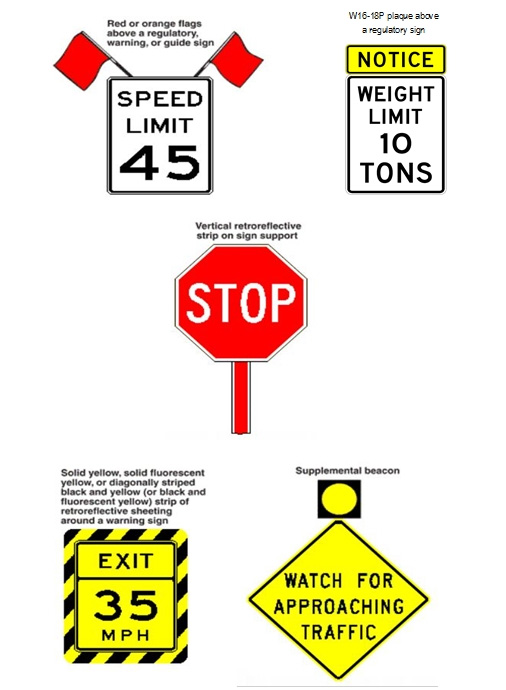
Option. Based upon engineering judgment, where the improvement of the conspicuity of a standard regulatory, warning, or guide sign is desired, any of the following methods may be used, as appropriate, to enhance the sign’s conspicuity (see Fig. 903.2.25.1):
A. Increasing the size of a standard regulatory, warning, or guide sign.
B. Doubling-up of a standard regulatory, warning, or guide sign by adding a second identical sign on the left-hand side of the roadway.
C. Adding one or more red flags (cloth or retroreflective sheeting) above a standard regulatory or warning sign, with the flags oriented so as to be at 45 degrees to the vertical.
D. Adding a solid fluorescent yellow rectangular plaque above a standard regulatory sign, with the width of the panel corresponding to the width of the standard regulatory sign. A legend of “NOTICE” may be added in black letters within the plaque determined by engineering judgment (see EPG 903.6.59 NOTICE Plaque).
E. Adding a diagonally striped black and fluorescent yellow strip of retroreflective sheeting around the perimeter of a standard warning sign.
F. Adding a warning beacon (see EPG 902 Signals) to a standard regulatory (other than a STOP or a Speed Limit sign), warning, or guide sign.
G. Adding a speed limit sign beacon (see EPG 902) to a standard Speed Limit sign.
H. Adding a stop beacon (see EPG 902) to a STOP sign.
I. Adding light emitting diode (LED) units within the symbol or legend of a sign or border of a standard regulatory, warning, or guide sign, as provided in EPG 903.2.17.
J. Adding a strip of retroreflective material to the sign support in compliance with the provisions of EPG 903.3.15.
K. Using other methods that are specifically allowed for certain signs as described elsewhere in the EPG.
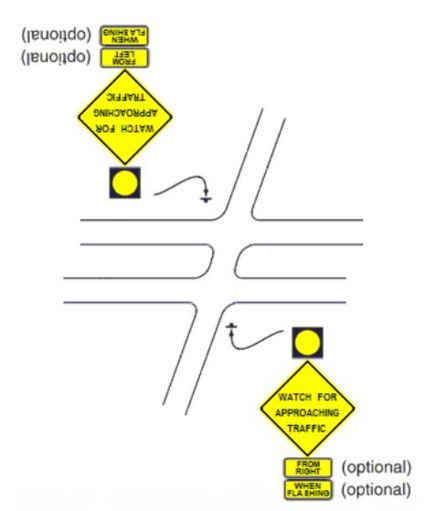
Support. Sign conspicuity improvements can also be achieved by removing non-essential and illegal signs from the right of way (see EPG 900), and by relocating signs to provide better spacing.
Standard. Strobe lights shall not be used to enhance the conspicuity of highway signs.
If installed for improvement of the conspicuity of intersection signing, the WATCH FOR APPROACHING TRAFFIC (special) sign shall be used, see Fig. 903.2.25.2.
If plaques are used, they shall be installed below the main sign, up to two plaques.
A warning beacon shall be set on steady flash if a problem would occur with the beacon.
Option. The WHEN FLASHING (W16-13P) plaque may be used.
The FROM LEFT or FROM RIGHT (special) plaque may be used.
Guidance. Routine inspection of the beacon should be done and determined by the district.
903.2.26 Location Standardization (MUTCD Section 2A.16)
Support. Standardization of position cannot always be attained in practice. Examples of heights and lateral locations of signs for typical installations are illustrated in Fig. 903.2.26.1 and examples of locations for typical signs at intersections are illustrated in Fig. 903.2.26.2.
EPG 903.5, EPG 903.6 and EPG 903.7 contain provisions regarding the application of regulatory, warning and conventional guide signs, respectively.
Standard. Signs requiring separate decisions by the traveler shall be spaced sufficiently far apart for the appropriate decisions to be made. One of the factors considered when determining the appropriate spacing shall be the posted or 85th-percentile speed.
Guidance. Signs should be located on the right-hand side of the roadway where they are easily recognized and understood by travelers. Signs in other locations should be considered only as supplementary to signs in the normal locations, except as otherwise provided in this article.
Signs should be individually installed on separate posts or mountings except where:
- A. One sign supplements another, or
- B. Route or directional signs are grouped to clarify information to motorists, or
- C. Regulatory signs that do not conflict with each other are grouped, such as turn prohibition signs posted with ONE WAY signs or a parking regulation sign posted with a speed limit sign.
- D. Street name signs are posted with a STOP or YIELD sign.
Signs should be located so that they:
- A. Are outside the clear zone unless placed on a breakaway or yielding support (see Lateral Offset);
- B. Optimize nighttime visibility;
- C. Minimize the effects of mud splatter and debris;
- D. Do not obscure each other;
- E. Do not obscure the sight distance to approaching vehicles on the major street for drivers who are stopped on minor-street approaches;
- F. Are not hidden from view; and
- G. Do not block view of intersection.
Support. The clear zone is the roadside border area measured from the edge of the pavement that is available for the safe use by errant vehicles as determined according to the EPG. The width of the clear zone depends on traffic volumes, speeds and roadside geometry.
Guidance. Because of increased traffic, an order of sign installation priority should be established to provide travelers with regulatory, warning, and guidance information.
Support. An order of priority is especially critical where space is limited for sign installation and there is a demand for several different types of signs. Overloading motorists with too much information is not desirable.
Guidance. Because regulatory and warning information is more critical to travelers than guidance information, regulatory and warning signing whose location is critical should be displayed rather than guide signing in cases where conflicts occur. Community wayfinding and acknowledgment guide signs should have a lower priority as to placement than other guide signs. Information of a lesser critical nature should be moved to less critical locations or omitted.
Option. Signs may be placed on median islands or on the left-hand side of the road under some circumstances, such as on curves to the right. A supplementary sign located on the left-hand side of the roadway may be used on a multi-lane road where traffic in a lane to the right might obstruct the view to the right.
Guidance. In urban areas where crosswalks exist, signs should not be placed within 4 ft. in advance of the crosswalk.
